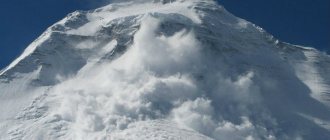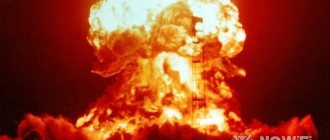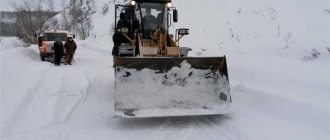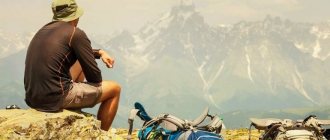Landslides, landslides, mudflows
Landslide
Landslide
A landslide is the movement of massive rocks down a slope under the force of gravity. Their formation occurs in different places through changes in their balance and permanent weakening. The cause of occurrence is natural and artificial reasons. Natural: steep slopes have increased, the bases of sea and river waters have been eroded, as well as seismic activity. Artificial: the slopes have collapsed due to road cuttings, excessive soil removal, improper use of agriculture on the slopes.
Sel
Mudflows are rapid mud or mud-stone flows consisting of mixtures of water and rock fragments that suddenly appear in river basins in the mountains. Characteristics of formation - a sharp rise in water levels, wave movement, short-term action, destructive effect.
Classification according to impacts on structures:
- With low power. Small size, clogging of the passage structure with water.
- With average power. Severe erosion, complete blockage, destruction of buildings.
- With great power. Huge force of destruction, destruction of farms, demolition of bridges and roads.
- Catastrophe. A destructive force that demolishes buildings and roads.
Collapses
Landslides are separations and catastrophic falls of huge masses of rocks from mountains. They overturn, crush and roll down steep and steep slopes. Most often they occur in mountainous areas, where there is a seashore. They occur due to weathering, erosion, dissolution and gravity. Their formation occurs in connection with the geological structure of the area, the presence of cracks on the slopes and the crushing of mountain rocks.
We recommend reading:
How to choose equipment for a winter hike
The main damaging factor of all three natural phenomena is the impact that moves along the slopes of the mountains, and especially in connection with the collapse and flooding of masses. In the end, destruction occurs of buildings that are hidden under the thickness of rocks, under economic objects, agricultural and forest land, blocking the river bed and overpass, as well as changes in the landscape.
Collapse
Snow avalanches
A snow avalanche is a mass of snow falling from a mountainside under the force of gravity.
Avalanche-forming factor : old snow, underlying surface, growth of fallen snow, snow level, snowfall intensity, snowstorm, air temperature and snow cover.
An important factor that influences the formation of snow avalanches is a temperature level equal to zero, an unstable increased position.
Avalanches usually begin to increase in spring.
Classification according to the degree of impact on households. activity:
- Natural . Such a collapse begins to entail significant material damage to structures, various resorts, railways and road routes.
- A dangerous phenomenon is avalanches, which complicate the activities of organizations and also threaten residents of populated areas and tourists.
snow avalanche
Earthquakes
An earthquake is a shift under the earth's crust, a vibration of the earth's cover, which is caused by natural processes and occurs inside the earth. Earthquakes are divided into three categories, as well as by the type of seaquakes. In their destructive actions they are similar to the shock wave of nuclear explosions.
Earthquake
What is a landslide and where does it form?
As a natural disaster, the occurrence of a landslide occurs in mountainous areas, where a mass shift occurs on their slopes with an uneven structure of weak plastic and impermeable rocks, overlain by strong permeable rocks.
A rocky mass with huge boulders, mud and numerous crumbles of small stones, moving at incredible speed and covering an area of up to several thousand square meters - this is a landslide.
But there are two more types of stone displacement:
- mudflows
or mudflows, whose stormy mud-stone and mud flows, consisting of a water mixture with rocks and arising due to a sharp rise in the water level of mountain rivers or heavy rains, suddenly burst out, destroying everything in their path;
- snow avalanches
consisting of a mixture of air and snow crystals.
Causes of earthquakes
A large number of earthquakes on our planet occur as a result of the displacement of tectonic plates, at which point sharp displacements of rocks occur. Undersea earthquakes occur when tectonic plates collide on the ocean floor or close to shore.
Damaging factors
The main damaging factors of landslides, mudflows, and landslides are considered to be moving impacts, as well as collapse or flooding with rocks. The danger of snow avalanches is when a huge amount of snow with great power demolishes everything that stands in its way.
Consequences of landslides, mudflows, landslides and avalanches
The consequences of such natural phenomena: destruction of buildings and structures, power lines, water supplies and sewers, railways and roads. They hide settlements, economic facilities, agricultural and forest lands under the thickness of rocks.
Behavior rules
If there is a threat of landslides, mudflows or avalanches, they organize in advance the evacuation of the population, agricultural animals and property from dangerous zones to safe places.
Author of the publication
offline 3 years
Nika
10
I am interested in hiking and traveling, photography and videography. I have been going hiking since childhood. The whole family went and went - sometimes to the sea, then to the river, to the lake, to the forest. There was a time when we spent a whole month in the forest. We lived in tents and cooked over fires. This is probably why I am still drawn to the forest and, in general, to nature. I travel regularly. About three trips a year for 10-15 days and many 2 and 3 day hikes.
Comments: 0Publications: 668Registration: 10/23/2018
Nika Wild Survival
Independent work on the topic: “Collapses, landslides, mudflows” (7th grade)
Independent work on the topic: “Collapses, landslides, mudflows” Option No. 1
1.
What is the main reason for the formation of landslides:
a) volcanic activity; b) shift of rocks;
c) water seeping through cracks and pores deep into the rocks and carrying out destructive work there; d) precipitation in the form of rain or snow.
(V)
2.
A mountain stream consisting of a mixture of water and loose clastic rock is called:
a) a landslide; b) mudflow; c) landslide; d) an avalanche.
(b)
3.
List the consequences of landslides, mudflows, landslides and avalanches?
Choose the correct answers: a) blocking river beds and changing the landscape; b) changes in climate and weather conditions; c) death of people and animals; d) forest fires; e) destruction of buildings and structures; f) concealment of populated areas, national economic facilities, agricultural and forest lands by rock strata; g) volcanic eruptions.
(a; c; d; f)
4.
The detachment and catastrophic fall of large masses of rocks , their overturning, crushing and rolling down on steep and steep slopes is:
a) rockfall; b) landslide; c) collapse.
(V)
5. Which areas are most susceptible to avalanche danger in our country?
A) Valdai Upland; b) all southern and northeastern mountainous regions; c) Kamchatka, Kuril Islands, Sakhalin, mountain of the Bama zone; d) polar mountains from the Kola Peninsula to Chukotka; e) The southern part of the Ural Mountains.
(b,c,d)
6. Why are mudflows and landslides dangerous for people and the economy?
A) the danger is greatly exaggerated; b) buildings, roads, hydraulic structures are destroyed; c) power lines fail; d) settlements, housing and industrial buildings with the population in them are destroyed.
(b,c,d)
Independent work on the topic: “Collapses, landslides, mudflows” Option No. 2
1.
The main cause of large landslides is:
a) melting of glaciers; b) earthquakes; c) hurricanes; d) floods.
(b)
2.
The rapid, sudden movement of snow and (or) ice down steep mountain slopes is called
:
a) snow storm; b) mudflow; c) collapse; d) an avalanche.
(G)
3.
The main damaging factors of landslides, mudflows, avalanches and snow avalanches are:
a) wave vibrations in rocks; b) hot lava flows; c) impacts from moving rock masses; d) blast wave;
e) collapse or flooding of a certain space by moving masses of rocks.
(c; d)
4.
Select from the proposed options the reasons for the formation of mudflows:
a) movements of the earth’s crust or earthquakes; b) floods caused by accidents at hydraulic structures; c) forest and peat fires;
d) the natural process of destruction of mountains; e) volcanic eruptions;
f) direct impact of sunlight on glaciers; g) human economic activity.
(a; d; e; g)
5. What methods (measures) exist to reduce losses from landslides, mudflows, collapses, and avalanches?
A) elimination of vegetation on dangerous slopes; b) observation and forecasting, which are carried out by specialized anti-landslide and anti-mudflow stations, parties and posts of the hydrometeorological service; c) special engineering structures (avalanche cutters, avalanche arresters); d digging ditches, ditches and laying roads on dangerous slopes.
(b,c)
6.What problems do snow drifts and landslides create for people in economic activity?
A) cause floods; b) cause destruction; c) cause disruptions to transport communications; d) cause damage to power lines.
(c,d)
Test on life safety, grade 7, “Collapses, landslides, mudslides” test on life safety (grade 7)
Test on the topic: “Collapses, landslides, mudflows”
Instructions. You have 20 minutes to complete the test. When answering test questions, you must choose one answer option.
1. What is a collapse?
- separation and fall of large masses of rocks, their overturning, crushing and rolling down on steep and steep slopes
- collapse of a mass of snow on mountain slopes
- sliding downward displacement of soil masses under the influence of gravity
- mountain stream consisting of a mixture of water, mud and stones
2. In which areas do landslides most often occur?
- on the slopes
- in mountainous areas
- on sea cliffs
- on the cliffs of river valleys
3. What types of collapses are there?
- mountain
- catastrophic
- with the collapse of giant rock masses
- rock and earth collapses
4. If the threat of a collapse is known in advance, the unified state system for warning and liquidation of emergency situations will organize...
- early distribution of essential kits to the population
- gradual collapse of rocks by low-power explosions
- early evacuation of the population to safe places
- construction of protective structures in landslide-prone areas
5. What is a landslide?
- separation and fall of large masses of rocks, their overturning, crushing and rolling down on steep and steep slopes
- collapse of a mass of snow on mountain slopes.
- sliding downward displacement of soil masses under the influence of gravity
- mountain stream consisting of a mixture of water, mud and stones
6. In which areas do landslides most often occur?
- on the slopes
- in mountainous areas
- in water
- in the forest belt
7.On what slopes can landslides occur?
- on a slope steepness of 19o
- on all slopes
- on a slope steepness of 45o
- on clay soils with a slope steepness of 5-7o
8.What types of landslides are there?
- large, medium and small scale
- continuous, intermittent and mixed
- linear and fissure
- grandiose, simple and small
9.What measures are organized to protect people from landslides?
- landslide control and forecast
- anti-landslide measures
- events are not organized because the landslide is not predictable
- surface water drainage
10. A mountain stream consisting of a mixture of water and rocks is called?
1. collapse
2. selem
3. landslide
4. avalanche
11. What are the main reasons for the formation of mudflows?
1. earthquakes, volcanic eruptions, snow melting, heavy rains, human activities
2. floods caused by accidents at hydraulic structures
3. forest and peat fires
4. direct impact of sunlight on glaciers
12. What are the main damaging factors of landslides, mudflows, landslides?
1. wave vibrations in rocks
2. hot lava flows
3.impacts of moving masses of rocks or soil, collapse or flooding of a certain space by moving masses of rocks
4. blast wave
13. Name the safest places in the event of landslides, mudflows, landslides...
1. gorges and recesses between mountains
2. hills, mountain slopes and hills
3.valleys between mountains with villages and avalanche-prone areas
4. large stones behind which you can hide.
14. You live in a mudflow-prone area. While at home, we heard a radio message about the threat of a mudflow. You have 30 minutes left. Choose your actions from the options provided...
1. collect all valuable property in the yard and hide it indoors
2. go to a safe place, go to higher ground, warn your neighbors about the threat of mudflow
3.you will go out onto the mountainside through a gorge or a small valley
4. take refuge in the cellar.
Answers to the test:
- 1 8. 1
- 2 9. 2
- 2 10. 2
- 3 11. 1
- 3 12. 3
- 1 13. 2
- 3 14. 2











